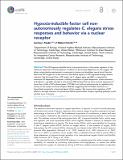| dc.contributor.author | Pender, Corinne Lenore | |
| dc.contributor.author | Horvitz, Howard Robert | |
| dc.date.accessioned | 2020-07-07T19:36:28Z | |
| dc.date.available | 2020-07-07T19:36:28Z | |
| dc.date.issued | 2018-07 | |
| dc.date.submitted | 2018-03 | |
| dc.identifier.issn | 2050-084X | |
| dc.identifier.uri | https://hdl.handle.net/1721.1/126077 | |
| dc.description.abstract | The HIF (hypoxia-inducible factor) transcription factor is the master regulator of the metazoan response to chronic hypoxia. In addition to promoting adaptations to low oxygen, HIF drives cytoprotective mechanisms in response to stresses and modulates neural circuit function. How most HIF targets act in the control of the diverse aspects of HIF-regulated biology remains unknown. We discovered that a HIF target, the C. elegans gene cyp-36A1, is required for numerous HIF-dependent processes, including modulation of gene expression, stress resistance, and behavior. cyp-36A1encodes a cytochrome P450 enzyme that we show controls expression of more than a third of HIF-induced genes. CYP-36A1 acts cell non-autonomously by regulating the activity of the nuclear hormone receptor NHR-46, suggesting that CYP-36A1 functions as a biosynthetic enzyme for a hormone ligand of this receptor. We propose that regulation of HIF effectors through activation of cytochrome P450 enzyme/nuclear receptor signaling pathways could similarly occur in humans. | en_US |
| dc.description.sponsorship | National Institutes of Health (Grant GM024663) | en_US |
| dc.description.sponsorship | National Institutes of Health (Grant T32GM007287) | en_US |
| dc.language.iso | en | |
| dc.publisher | eLife Sciences Publications, Ltd | en_US |
| dc.relation.isversionof | http://dx.doi.org/10.7554/elife.36828 | en_US |
| dc.rights | Creative Commons Attribution 4.0 International license | en_US |
| dc.rights.uri | https://creativecommons.org/licenses/by/4.0/ | en_US |
| dc.source | eLife | en_US |
| dc.title | Hypoxia-inducible factor cell non-autonomously regulates C. elegans stress responses and behavior via a nuclear receptor | en_US |
| dc.type | Article | en_US |
| dc.identifier.citation | Pender, Corrine L. and H. Robert Horvitz. "Hypoxia-inducible factor cell non-autonomously regulates C. elegans stress responses and behavior via a nuclear receptor." eLife 7 (July 2018): e36828 © 2018 Pender and Horvitz | en_US |
| dc.contributor.department | Massachusetts Institute of Technology. Department of Biology | en_US |
| dc.contributor.department | McGovern Institute for Brain Research at MIT | en_US |
| dc.contributor.department | Koch Institute for Integrative Cancer Research at MIT | en_US |
| dc.relation.journal | eLIfe | en_US |
| dc.eprint.version | Final published version | en_US |
| dc.type.uri | http://purl.org/eprint/type/JournalArticle | en_US |
| eprint.status | http://purl.org/eprint/status/PeerReviewed | en_US |
| dc.date.updated | 2019-12-05T18:26:02Z | |
| dspace.date.submission | 2019-12-05T18:26:04Z | |
| mit.journal.volume | 7 | en_US |
| mit.metadata.status | Complete | |
